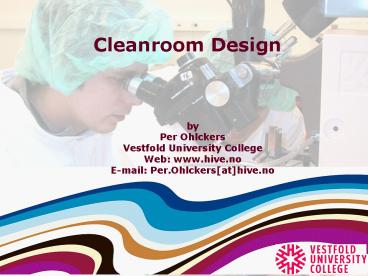Cleanroom Design PowerPoint PPT Presentation
1 / 15
Title: Cleanroom Design
1
Cleanroom Design
- by
- Per Ohlckers
- Vestfold University College
- Web www.hive.no
- E-mail Per.Ohlckersathive.no
2
Outline
- Introduction
- Why do we need cleanrooms
- Basic requirements for cleanrooms
- Earlier
- Present
- Future
- Main Application Fields for Cleanrooms
- Microelectronics
- Biotechnology and related fields
- Other fields Microtechnology, electronics,
hospital care, etc - Basic Structures and Components of Cleanrooms
- Clean air
- Stable Room Temperature
- Clean water
- Chemicals including gases
- Vibration damping
- Equipments with infrastructure
- Working in cleanrooms
- Best practices
3
A typical cleanroom
4
Introduction
- Why do we need cleanrooms
- Basic requirements for cleanrooms
- Earlier Clean air, stable temperature, stable
humidity, clean water, gases and chemicals,
lighting, processing equipment, inspection and
test equipment, room infrastructure, etc. - High investments and operating costs.
- Present As earlier at better performance
vibration control - Investments and operating costs very high
- Future You would not want know
- Main Application Fields for Cleanrooms
- Microelectronics
- Biotechnology and related fields
- Other fields Microtechnology, electronics,
hospital care, etc
5
Basic Structures and Components of Cleanrooms
- Clean air
- Overpressure
- Filters
- HEPA ( High Efficiency Particulate Air) filters
- Humidity Control
- Stable Room Temperature 22 -2 centigrades?
- Clean Water Filtered and deionized water
- Chemicals
- Equipment with infrastructure
- Aligners
- Ovens
- etc
- Working in Cleanrooms
- Best Practices
6
Clean room classification
7
Dust/particle sizes
8
Utilities (infra-structure)
9
Clean water
10
Laminar Air Flow
11
HEPA (High Efficiency Particulate Air) filter
12
Mechanical Vibration Control
- Submicron processing needs vibration control
- Typical requirements are
- Sorry, hopefully to be filled in later.
13
On-site vibration measurement spectra of the
stepper (g386.4 in./sec2).
14
Working in Cleanrooms
- Best Practices
- Cleanroom workers are dust generators
- Cleanroom gowning Bunny suit etc.
- Dos and Donts
- Possible health hazards should be taken seriously
(but a good job for people with breathing air
related health problems, like asthma.
15
Conclusions
- Cleanrooms are necessary for microtechnology
production and prototyping - Cleanrooms are complex structures
- Cleanrooms are very expensive to build and
operate - Cleanroom work is a skill that needs to be
learned. - Requirements for cleanrooms getting tougher and
tougher as microtechnologies mature further

